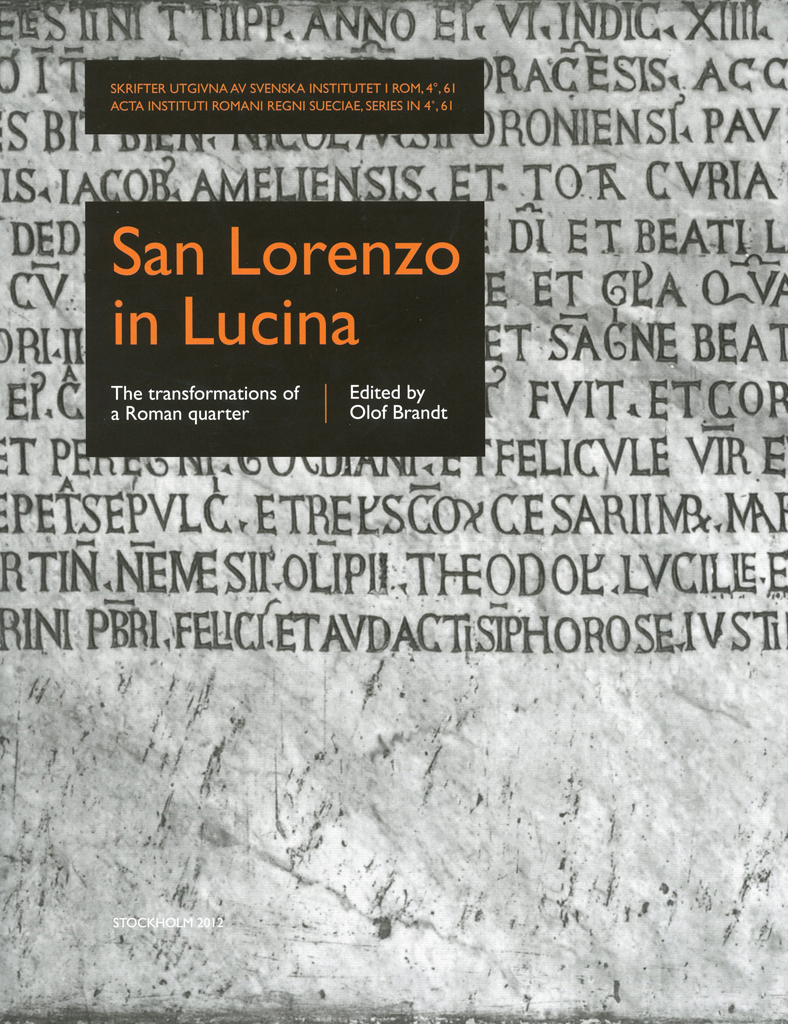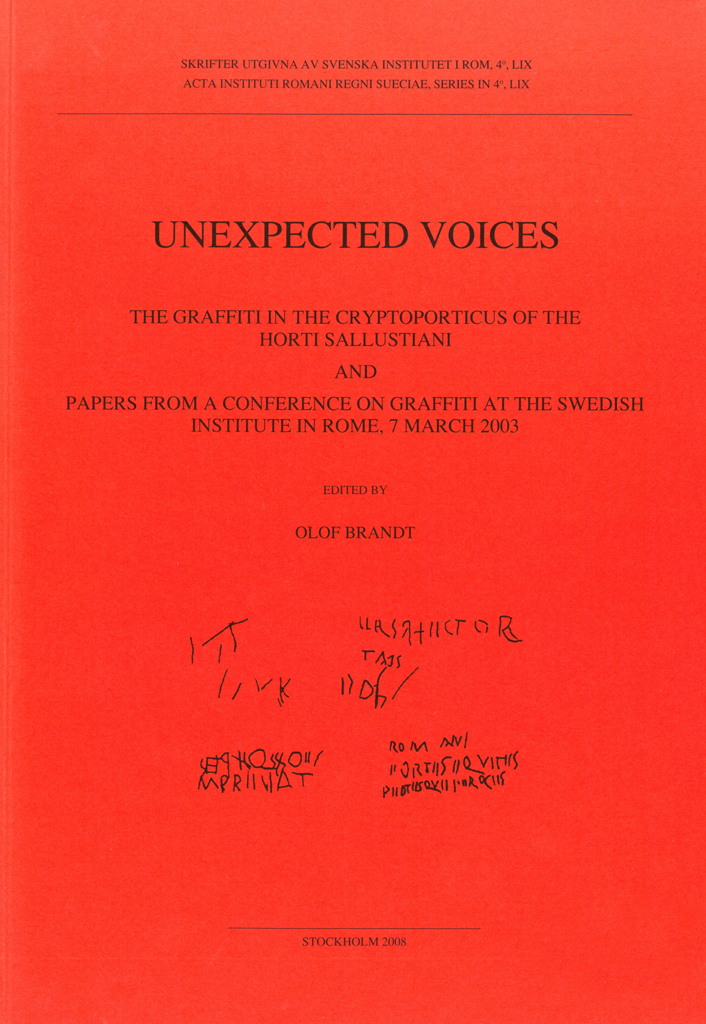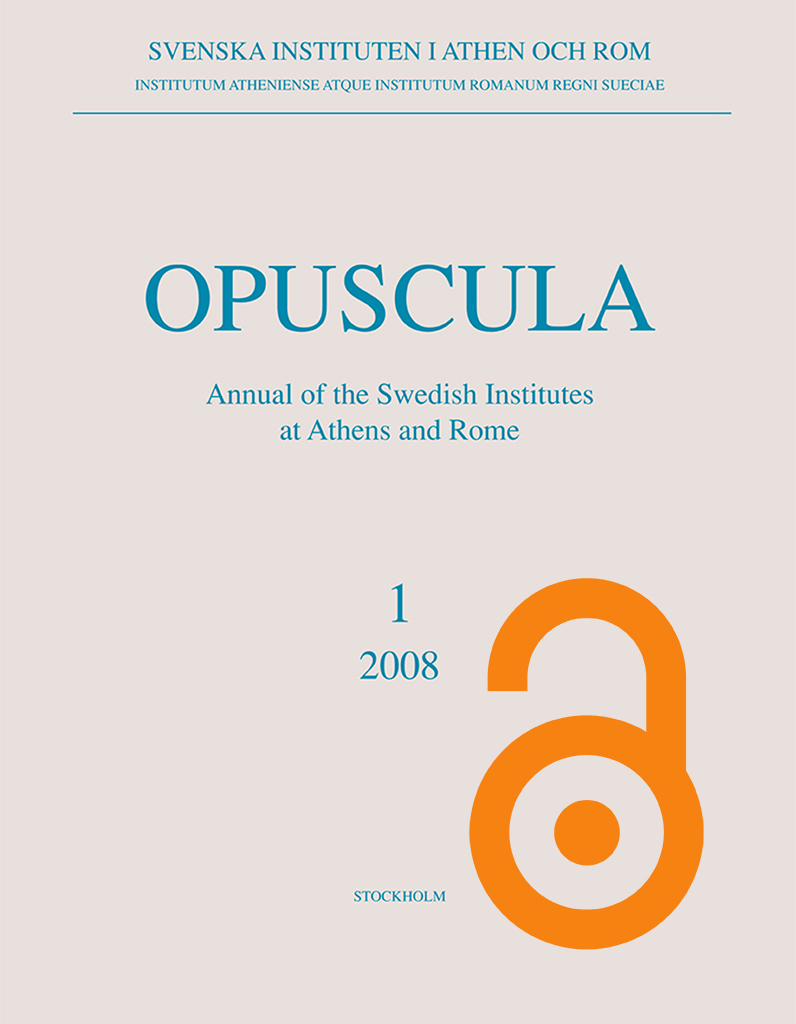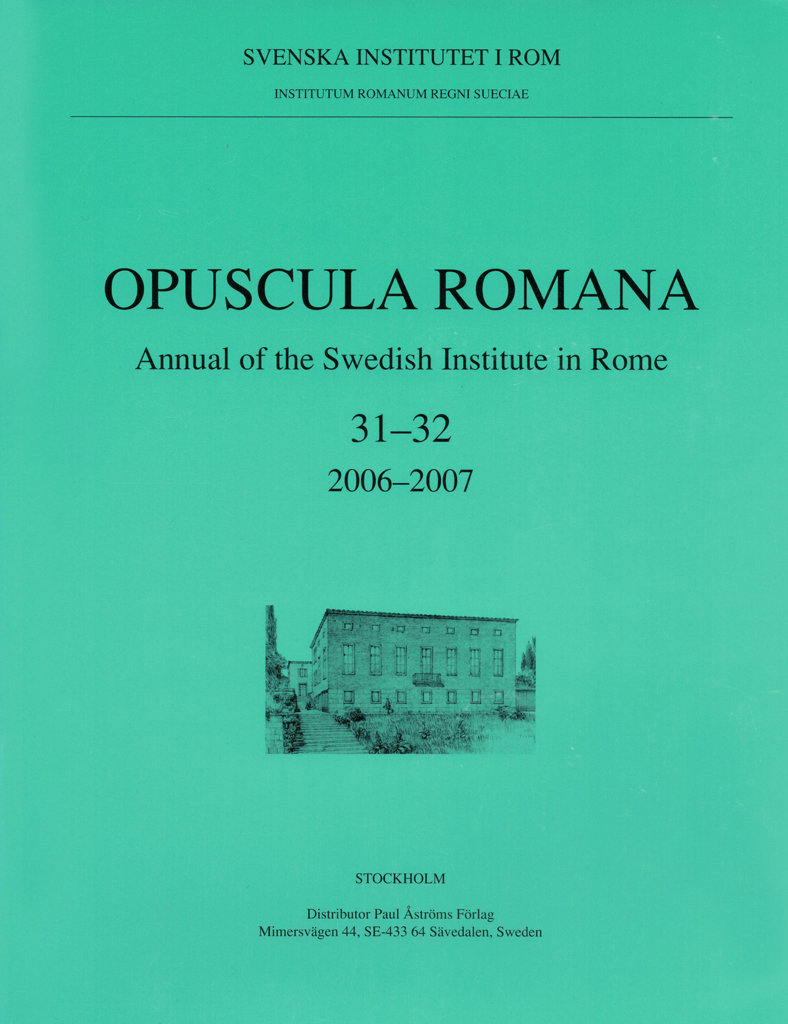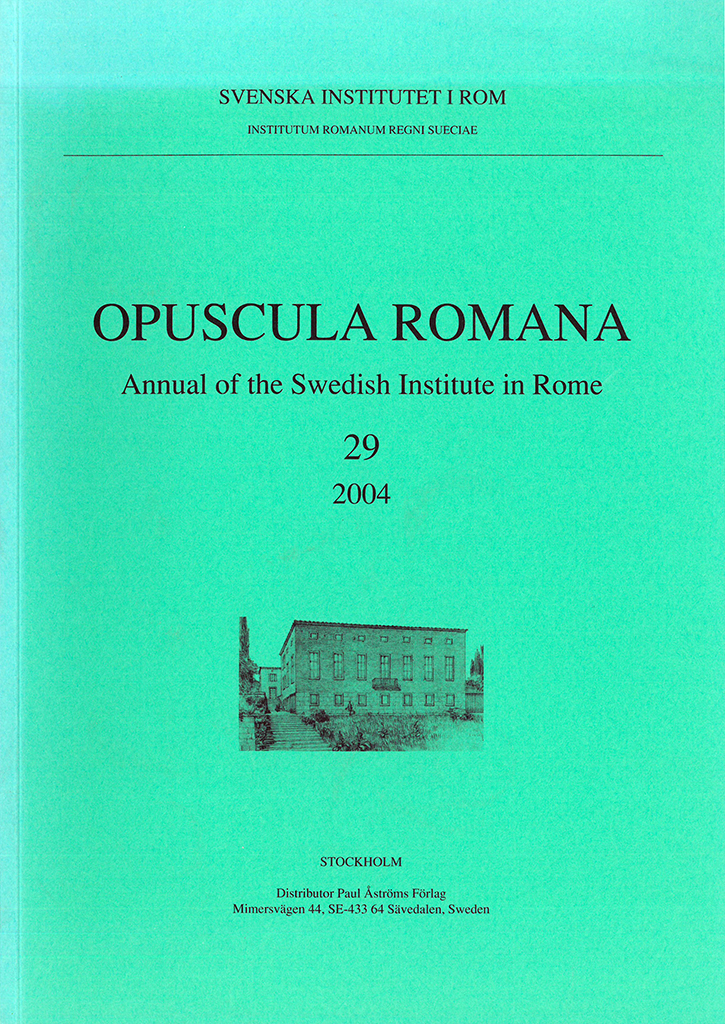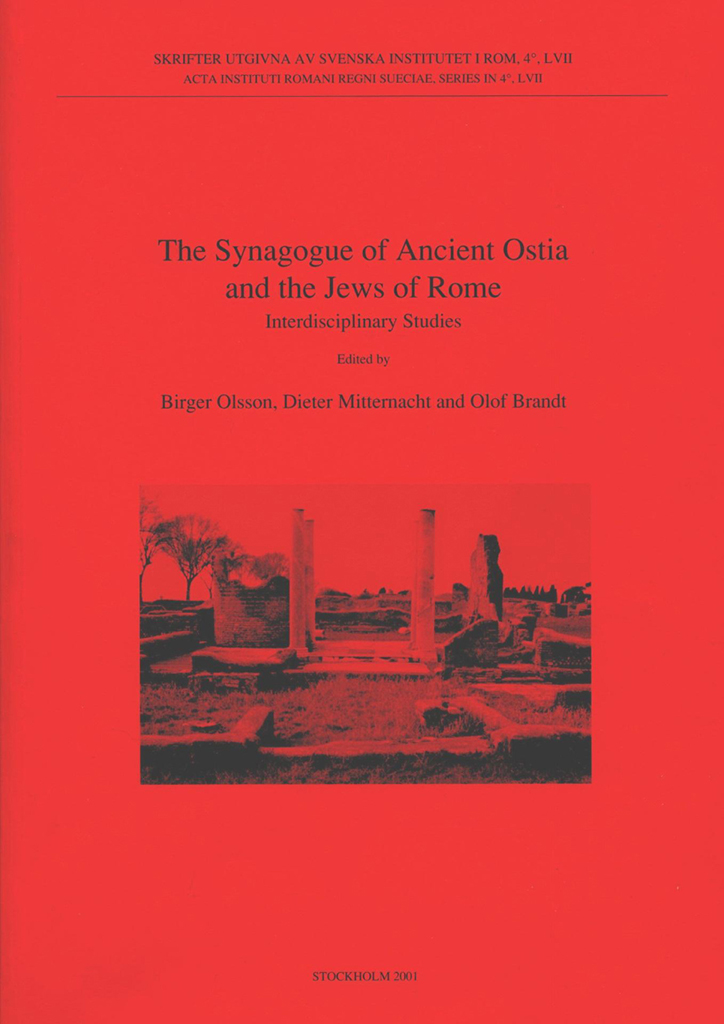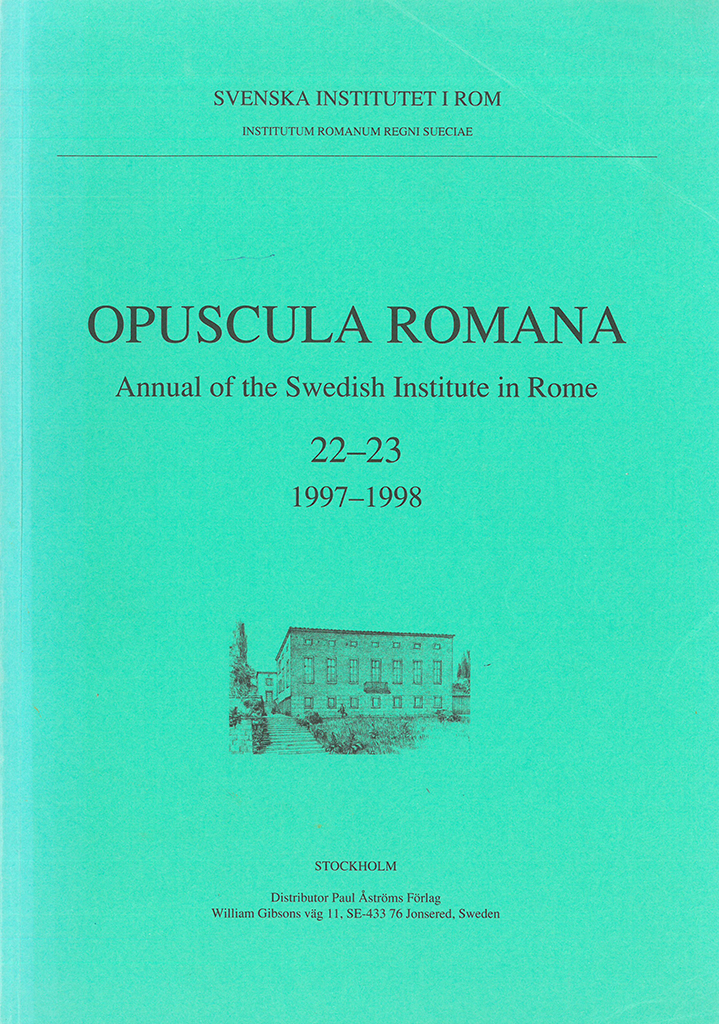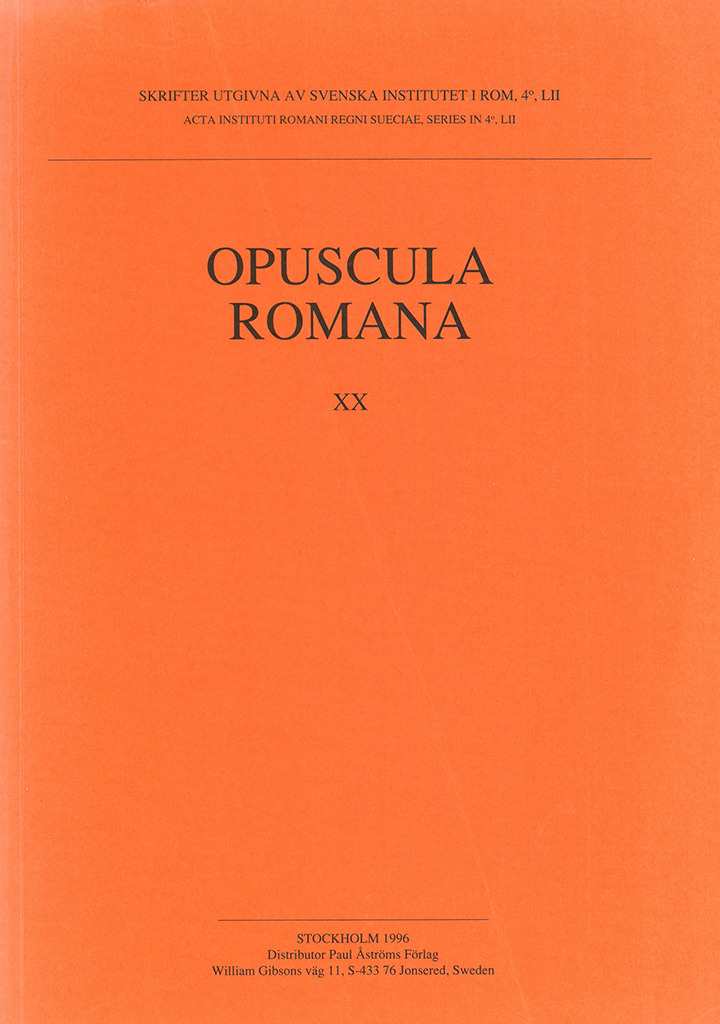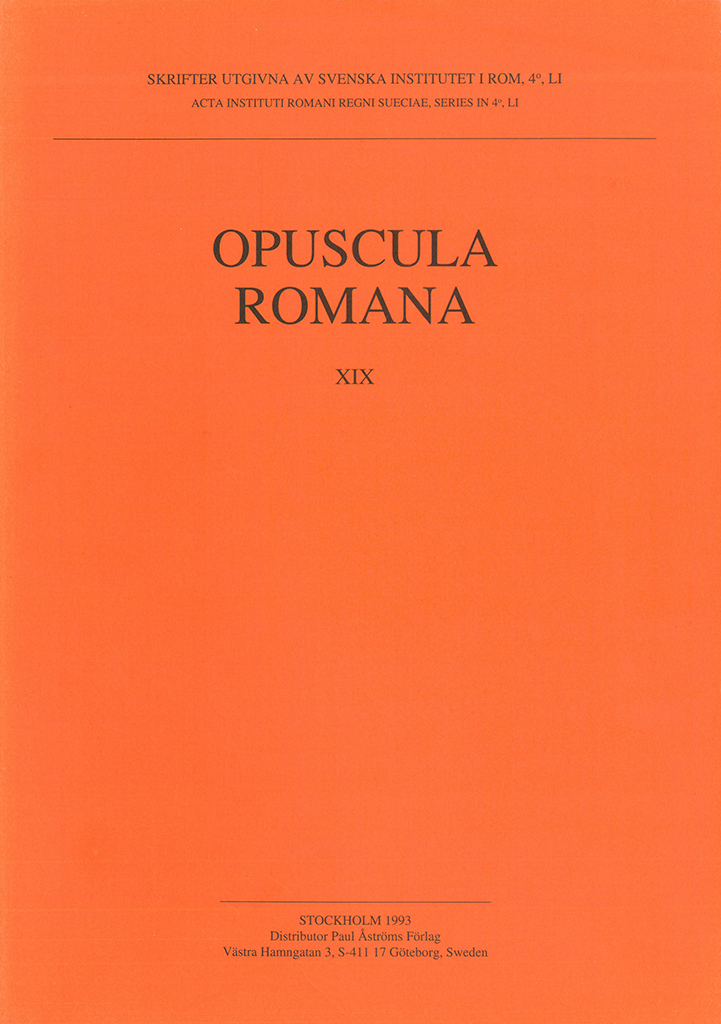Published by the Swedish Institute of Classical Studies in Rome. Distributed by Eddy.se AB. San Lorenzo in Lucina. The transformations of a Roman quarter Edited by Olof Brandt Abstract This volume presents the results of research carried out by the Swedish Institute in Rome in the Roman church of San Lorenzo in Lucina. This research involved the Roman phases of the site and the surrounding quarter. The research began with the 1993–1998 excavation of the baptistery of the Early Christian church, and continued in 2000 with a project which also included other parts, aspects and periods of the site. The papers in this volume shed new light on the Late Roman and post-Antique development of an area which is between Augustan monuments such as the Ara Pacis, the Mausoleum of Augustus, the obelisk and its meridian. The papers include studies on the early 3rd century insula beneath the church, the baptistery and the Early Christian basilica, as well a survey of hagiographic legends, medieval wall-paintings, and other finds such as inscriptions and graffiti, pottery, glass, marble, bones and spolia. Reports on the conservation on fragments of Roman wall-paintings and marble fragments are also included. Contents Barbro Santillo Frizell, ‘Preface’ Olof…
Published by the Swedish Institute of Classical Studies in Rome. Distributed by Eddy.se AB. Via Tiburtina. Space, movement and artefacts in the urban landscape Edited by Hans Bjur & Barbro Santillo Frizell Abstract How can cities integrate historic layers into their urban development? How can tangible and intangible heritages be read, interpreted and utilised in a sustainable city and landscape development? What significance could an ancient road have in this context? These are the overall questions in this book. It contains a number of different approaches to the interaction between the ancient road Via Tiburtina and the surrounding urban landscape east of Rome towards Tivoli, a rich palimpsest of distinguishable interrelated layers created over at least three millennia. One hypothesis being explored is that structures like Via Tiburtina still can determine the morphology of the urban landscape. Settlements, buildings, space, movement and cultural artefacts have therefore come into focus in investigating whether broken connections could be re-established, and thus creating a dialogue between Rome’s earlier epochs and the future. Contents Index map Introduction Hans Bjur & Barbro Santillo Frizell | Ways to urban landscape archaeology Hans Bjur | That’s the way it is Movement Barbro Santillo Frizell | Changing pastures…
Published by the Swedish Institute of Classical Studies in Rome. Distributed by Eddy.se AB. Unexpected voices. The graffiti in the cryptoporticus of the Horti Sallustiani and papers from a conference on graffiti at the Swedish Institute in Rome, 7 march 2003 Edited by Olof Brandt Abstract This volume presents the results of a collaboration between the Swedish Institute in Rome and the Embassy of the United States of America in Rome. The object of the research was a cryptoporticus, part of the ancient Horti Sallustiani, in the area of the American Embassy, and especially the graffiti found on the walls of the cryptoporticus, which were also decorated with paintings. The cryptoporticus, which is dated to the first century AD, was excavated in 1949–1950 and in the 1990s, but the graffiti have never been completely published. In this publication, all the graffiti are discussed and dated. Some belong to Late Antiquity, others were made in the 16th and 17th centuries. The study of these graffiti gives important information about the later fate of the first-century cryptoporticus. Several unpublished fragments of wall-paintings are also presented, and more general historic and archaeological aspects of the cryptoporticus are discussed. Part of the project was…
Opuscula is published by the Swedish Institutes at Athens and Rome, with the aid of a grant from the Swedish Research Council. Distributed by Eddy.se AB. View journal at ERIH PLUS. Content available with open access. Opuscula. Annual of the Swedish Institutes at Athens and Rome 1, 2008 Contents ‘Front matter‘, 1–6 Katie Demakopoulou, Nicoletta Divari-Valakou, Monica Nilsson, Ann-Louise Schallin, with an appendix by Kalliopi Nikita, ‘Excavations in Midea 2006’, 7–30 https://doi.org/10.30549/opathrom-01-02 John K. Papadopoulos, ‘The Archaic wall of Athens. Reality or myth?’, 31–46 https://doi.org/10.30549/opathrom-01-03 Anton Bonnier, ‘Epineia kai limenes. The relationship between harbours and cities in ancient Greek texts’, 47–61 https://doi.org/10.30549/opathrom-01-04 Fabrizio Vistoli, ‘Una nuova acquisizione di ceramica “white-on red” dall’ager Veientanus’, 63–77 https://doi.org/10.30549/opathrom-01-05 Ola Wikander, ‘The religio-social message of the gold tablets of Pyrgi’, 79–84 https://doi.org/10.30549/opathrom-01-06 This contribution is only available in print. Milette Gaifmann, ‘Visualized rituals and dedicatory inscriptions on votive offerings to the Nymphs’, 85–103 https://doi.org/10.30549/opathrom-01-07 Gabriella Barbieri, ‘Materiali inediti da Sovana. Alcuni corredi funerari dalla necropoli di San Sebastiano’, 105–122 https://doi.org/10.30549/opathrom-01-08 This contribution is only available in print. Maria Gabriella Scapaticci, ‘Nuovi dati sul popolamento nella pianura di Tarquinia durante la romanizzazione. Il caso della località “Il Giglio”‘, 123–135 https://doi.org/10.30549/opathrom-01-09 Paavo Roos, ‘A forgotten tomb…
Published by the Swedish Institute of Classical Studies in Rome. Distributed by Eddy.se AB. Opuscula Romana. Annual of the Swedish Institute in Rome 31–32, 2006–2007 Contents Johnny R. Bengtsson | Late Bronze Age handles from the Apennine settlement at Luni sul Mignone: Some chronological observations Ingela M.B. Wiman & Yvonne Backe-Forsberg | Surfacing deities in later Etruscan art and the sacellum at San Giovenale Allan Klynne | The Villa Selvasecca revisited John W. Hayes | Villa Selvasecca: the pottery finds Ebba Engström & Ragnar Hedlund | Villa Selvasecca: the coins Dominic Ingemark | Villa Selvasecca: the glass Anne-Marie Leander Touati | Interim report of the Swedish Pompeii Project: Work 2000–2004/5 in Insula V 1. Introduction Margareta Staub Gierow | The House of the Greek Epigrams V 1,18.11–12: preliminary report 2000–2004 Arja Karivieri & Renée Forsell | The House of Caecilius Iucundus, V 1,22–27: a preliminary report Henrik Boman & Monica Nilsson | The commercial establishments V 1,13; V 1, 14–16; V 1,20–21: preliminary report 2001–2004 Mark Robinson | Evidence for garden cultivation and the use of bedding-out plants in the peristyle garden of the House of the Greek Epigrams (V 1, 18i) at Pompeii Henrik Boman & Monica Nilsson |…
Published by the Swedish Institute of Classical Studies in Rome. Distributed by Astrom Editions. Opuscula Romana. Annual of the Swedish Institute in Rome 29, 2004 Contents Olof Brandt | Jews and Christians in Late Antique Rome and Ostia: some aspects of archaeological and documentary evidence (pp. 7-27) Consuelo Cecchini & Caterina Pisu | Due tombe a camera inedite da ‘Poggio delle Ginestre’—Trevignano Romano (RM): informazioni archeologiche e dati topografici (pp. 29-46) Pamela Hemphill & Gabriella Barbieri | Materiali arcaici dal territorio di Blera (VT): la tomba 69 di Civitella Cesi (pp. 47-55) Karin Lundkvist | Priests in Livy (pp. 57-71) Margareta Strandberg Olofsson | White-on-red from Acquarossa: some large decorated vessels and their chronological implications (pp. 73-89) Book reviews Ingrid Pohl | W. Regter, Imitation and creation. Development of early bucchero design at Cerveteri in the seventh century BC (p. 91) Olof Brandt | M. Ghilardi, Subterranea Civitas. Quattro studi sulle catacombe romane dal medioevo all’età moderna (pp. 92-93) Books received (p. 94) Bibliographical information Opuscula Romana. Annual of the Swedish Institute in Rome 29, Stockholm 2005. ISSN 0471-7309. ISBN 91-7042-171-4. Softcover, 94 pages.
Published by the Swedish Institute of Classical Studies in Rome. Distributed by Astrom Editions. The Synagogue of Ancient Ostia and the Jews of Rome. Interdisciplinary studies Edited by Birger Olsson, Dieter Mitternacht & Olof Brandt Abstract In March of 1997 a research project on the ancient synagogue began at Lund University, Sweden, continuing a tradition of research that has its roots in the 1930s. The project’s title “The Ancient Synagogue: Birthplace of Two World Religions” suggests that Judaism and Christianity existed for a time in close proximity to each other and were shaped by the same particular milieu within the ancient world, namely, the synagogue. The synagogue in ancient Ostia was chosen as an initial case study, since there is evidence that it was built during the first century CE and consequently is one of the earlier synagogues in the Roman world to have been excavated. Olof Brandt presents for the first time a more extensive description of the area outside the city walls where the synagogue was built. Anders Runesson surveys all the material that has been published about Ostia in order to make a new reconstruction of the synagogue’s history in Ostia. Magnus Zetterholm attempts, primarily with the…
Published by the Swedish Institute of Classical Studies in Rome. Distributed by Astrom Editions. Opuscula Romana. Annual of the Swedish Institute in Rome 22–23, 1997–1998 Contents Olof Brandt, ‘Il battistero lateranense da Constantino a Ilaro. Un riesame degli scavi’, pp. 7–65 Daniel Fuglesang, ‘Two unpublished chamber tombs from San Giovenale’, pp. 67–89 Peter Liljenstolpe, ‘The Roman Blattkelch capital. Typology, origin and aspects of employment’, pp. 91–126 Peter Liljenstolpe & Allan Klynne, ‘The imperial gardens of the Villa of Livia at Prima Porta. A preliminary report on the 1997 campaign’, pp. 127–147 Manlio Lilli, ‘Un ambiente termale lungo la via Calmazzo—Urvinum Mataurense, presso il vicus di Canavaccio (PS)’, pp. 149–155 ‘The Swedish Institute in Rome. Report for the academic years 1996–1997 and 1997–1998’, pp. 157–160 Bibliographical information Opuscula Romana. Annual of the Swedish Institute in Rome 22–23, Stockholm 1998. ISSN 0471-7309. Softcover, 160 pages.
Published by the Swedish Institute of Classical Studies in Rome. Distributed by Astrom Editions. Pär Göran Gierow dedicata Opuscula Romana 20 Contents Kristina Berggren, Tre tombe a cremazione con trace di legno nella necropolis di Quattro Fontanili a Veio (Roma) Ingrid E.M. Edlund-Berry, The power of cults and sacred spaces. The interpretation romana of sanctuaries in southern Italy and Sicily Maria C. Eriksson, Two Etruscan mirrors in the Thorwaldsen Museum, Copenhagen Björn Forsén & Timo Sironen, Bolli laterizi romani nell’Antikmuseet in Göteborg Lena Landgren, The Roman pleasure garden—foundations for future studies Peter Liljenstolpe, De ornamentis templi Urbis. Reconstructing the main order of the temple of Venus and Roma in Rome Alessandro Naso, Osservazioni sull’origine dei tumuli monumentali nell’Italia centrale David Ridgway, Greek letters at Osteria dell’Osa Paavo Roos, Strabo and the water-mill at Cabeira. Some considerations Raffaele Santillo, Il «saxum ingentem» a Ravenna a copertura del Mausoleo di Teoderico: problemi e soluzioni Martin Söderlind, A central Italic, terracotta votive head in the Classical Museum of Antiquities in Lund (in association with Pierluigi Bianchetti, technical analysis) Margareta Strandberg Olofsson, Pottery from the monumental area at Acquarossa: a preliminary report Bengt E. Thomasson, Laterculi praesidium. Addendorum series altera Örjan Wikander, Senators and equites….
Published by the Swedish Institute of Classical Studies in Rome. Distributed by Astrom Editions. Opuscula Romana 19 Contents Articles Carl Nylander, Gustavo VI Adolfo, il “re archeologo” S.M. Il Re Gustavo VI Adolfo, Discorso in occasione del conferimento della laurea ad honorem Oxford 1955 Olle Brandt, Recent research on the tomb of Eurysaces Peter Danner, Stützen im Giebel—Ein Motiv der etruskischen Wandmalerei Harry Erkell, L’Imperatore Commodo ed Ercole-Melcart Pamela Hemphill, The Romans and the San Giovenale area Bo Lawergren, Lyres in the West (Italy, Greece) and East (Egypt, the Near East), ca. 2000 to 400 B.C. Örjan Wikander, Senators and equites V. Ancestral pride and genealogical studies in Late Republican Rome Charlotte Wikander, Acquarossa: campagna di scavo 1991 The Swedish Institute in Rome. Report for the academic years 1990–91 and 1991–92 Book reviews Charlotte Wikander, review of R.R. Knoop, Antefixa Satricana. Sixth-century architectural terracottas from the sanctuary of Mater Matuta at Satricum (Le Ferriere) Örjan Wikander, review of O. Salomies, Die römischen Vornamen. Studien zur römischen Namengebung Örjan Wikander, review of I. Nielsen, Thermae et balnea. The architecture and cultural history of Roman public baths Örjan Wikander, review of G. Brodribb, Roman brick and tile Göran Bäärnhielm, review of B….

